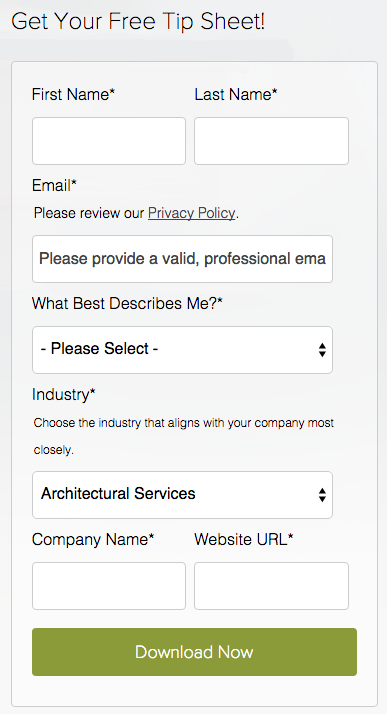



Managing an inbound marketing program is a lot like owning a car—it requires ongoing maintenance and fuel to make it run well. The work involved in doing inbound marketing well doesn’t end when a lead comes in. On the contrary—the work is really just beginning.
We’ve had a number of clients seek us out after getting started with inbound marketing who'd become frustrated because they didn't know what to do to turn their online inbound leads into paying customers. It's a common frustration, but can easily be avoided with a strategic, thoughtful approach to lead management.
Especially in a B2B context, having the right internal operations in place to qualify and nurture leads is critical to winning more sales and, ultimately, experiencing success with inbound marketing. In this article, we’ll explore some best practices to have in place to ensure you’ll see results when your inbound marketing efforts start bringing in new leads.
Generally, we break the B2B inbound marketing methodology into 7 steps:
It’s easy to get wrapped up in the first two steps when you’re getting started implementing inbound marketing: you identify your personas, distinguish their pain points, then develop valuable content that you use to attract and convert leads online. The process of producing and promoting content to attract new leads is very time- and effort-intensive, and it's easy to get caught in the idea that converting leads is your whole job.
However, if you don't continue through the methodology—to qualify and nurture leads through the inbound funnel—your leads will essentially get lost in space after they download your content. It's up to you to figure out what needs to happen next to move your leads further down the sales funnel.
Realistically, you have a number of new contacts coming in that, simply put, just aren't right for your business. At Weidert Group, for example, we get a number of students, job candidates, and other marketing agencies converting on our offers who don't represent real business opportunities. It's important to have parameters in place to qualify your contacts, which will help you distinguish the real opportunities from, well, everyone else—allowing you to focus your time and efforts on the leads who are most likely to become new customers.
 A simple way to do this is by implementing custom fields and smart forms with your marketing automation software. There's no reason to stick to the traditional "First Name, Last Name, Email, Company Name, Phone Number, State/Region" form fields that we've all become so accustomed to if that information doesn't truly matter to your industry. If you're a Software-as-a-Service company you might not care as much about where a prospect is located and can instead use that opportunity to find out about their current service provider.
A simple way to do this is by implementing custom fields and smart forms with your marketing automation software. There's no reason to stick to the traditional "First Name, Last Name, Email, Company Name, Phone Number, State/Region" form fields that we've all become so accustomed to if that information doesn't truly matter to your industry. If you're a Software-as-a-Service company you might not care as much about where a prospect is located and can instead use that opportunity to find out about their current service provider.
Think carefully about what information is really critical to your sales team's success in following up with a lead. We've had clients who've used custom fields and smart forms to capture information about annual revenue, number of employees, biggest pain with their current product/service, and so on; whatever makes the most sense for their industry and sales' needs.
By using custom fields and smart forms, your leads will start qualifying themselves—making less work for you! Take a look at the form fields we use, for example. We specialize in serving B2B industries such as equipment manufacturing, financial services & insurance, A/E/C services, and industrial distribution, so by knowing a contact's industry right off the bat, we know how qualified that lead is for business opportunities.
One of the greatest perks of using marketing automation software is the opportunity to set up nurturing workflows. Having workflows in place helps ensure that your leads continue to receive touches from you throughout their buyer's journey; these touches should work to provide that lead with the valuable, helpful information they need as they move from the awareness stage (when they're just identifying that they have a problem) to the consideration stage (when they're doing their research and finding out what their options are) to, finally, the decision stage (when they're ready to buy, and they know who they want to buy from).
When you promote a piece of content, think about the logical sequence of pieces that can serve as follow up materials. For example, if a lead downloads your "10 Reasons to Use a Central Vacuum System" tip sheet, having a workflow in place would ensure that contact receives follow up content straight to their inbox, such as your "Complete Guide to the Advantages of a Central Vacuum System for Businesses" eBook and "How a Central Vacuum System Installation Works" infographic. You can even dictate how many days to wait until the next piece is delivered (a good rule of thumb is to wait 7-10 days, depending on the length of your typical sales cycle).
Conversely, you can set up workflows even if someone hasn't shown interest in a piece of content yet. Let's say you send a promotional email featuring a call-to-action to download your tip sheet to your list of blog subscribers. You can set up a workflow to automatically deliver a different offer if a certain number of days have passed and that contact hasn't converted on your first offer (you could even craft the message to contain wording such as "We thought you might find this eBook particularly helpful..."). Of course, you'll want to avoid sending too many promotional emails at the risk of annoying your prospects, but using workflows serves as a nice follow up touch to show your prospects that you're thinking about them and are always trying to provide added value.
Topics: Marketing Automation
